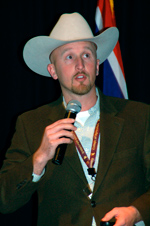Selecting for Efficiency Improves Profitability, Sustainability
Seedstock producer creates sire alliance to evaluate cost and return of a bull’s contribution to the herd in a real-world setting.
by Troy Smith for Angus Productions Inc.
CASPER, Wyo. (Dec. 2, 2009) — Why is efficiency important to the beef industry? According to Missouri cattleman Nick Hammett, it’s because improvements to efficiency help cattlemen lower costs, increase returns or both. While speaking to producers gathered for the 2009 Range Beef Cow Symposium in Casper, Wyo., Hammett said, in short, efficiency improves profitability and sustainability.
 Profitability-based selection indexes currently represent the gold standard by which multi-trait genetic progress is made, said Nick Hammett, Circle A Angus commercial marketing manager.Hammett is commercial marketing manager for Circle A Angus, which annually markets more than 400 bulls, 600 bred heifers, 50 registered females and 8,000 finished cattle. He explained how Circle A entered the purebred cattle industry, first concentrating on winning in the showring. Owner Dave Gust, a successful self-made businessman, soon shifted the operation’s focus to producing cattle that could help commercial producers improve their profitability.
Profitability-based selection indexes currently represent the gold standard by which multi-trait genetic progress is made, said Nick Hammett, Circle A Angus commercial marketing manager.Hammett is commercial marketing manager for Circle A Angus, which annually markets more than 400 bulls, 600 bred heifers, 50 registered females and 8,000 finished cattle. He explained how Circle A entered the purebred cattle industry, first concentrating on winning in the showring. Owner Dave Gust, a successful self-made businessman, soon shifted the operation’s focus to producing cattle that could help commercial producers improve their profitability.
“In 1996, he formulated the Angus Sire Alliance with the goal of measuring both the costs and returns of a sire’s progeny in a real-world, commercial setting to help guide mating and selection decisions based on actual profitability,” Hammett said.
With a membership including 51 like-minded Angus breeders, the Angus Sire Alliance collected feedlot and carcass data, becoming the largest contributor of carcass data to the American Angus Association. Missing, however, was any evaluation of production costs, a critical factor in measuring profitability.
Circle A constructed a research facility to test sire progeny for feed efficiency based on individual feed intake, Hammett shared. A partnership was formed with ABS Global to market semen from high-profitability sires. Ten to 12 sires are now tested annually utilizing a GrowSafe system capable of collecting individual feed intake measurements on 200 animals simultaneously. Expected progeny difference (EPD) values are calculated for birth weight, weaning weight, weaning weight maternal, postweaning average daily gain, marbling score, yield grade and dry-matter intake for inclusion in a profitability selection index.
After more than a decade of using progeny testing, EPDs and profitability indexing, genetic improvement for multiple traits is evident, Hammett said. By also using in-herd EPDs for heifer pregnancy and cow stayability, and calculating a maternal profit index as well as the terminal profit index, improvements have been made to the profitability of all facets of Circle A production.
“For us, the results of profitability indexing include increased fertility, allowing us to breed cows in lower body condition while maintaining pregnancy rates. We have improved feed efficiency and carcass traits, too — all simultaneously,” Hammett said.
Circle A has implemented a buy-back program through which it purchases cattle from bull-buying customers. Hammett said feed efficiency data enables Circle A to pay more for those cattle, guaranteeing sellers will receive prices equal to the top of the regional market plus a $25 premium because the cattle were sired by Circle A bulls.
According to Hammett, profitability-based selection indexes currently represent the gold standard by which multi-trait genetic progress is made. He advised producers to seek sources of genetics that are measuring and selecting for a variety of traits that directly affect the bottom line.
Editor’s Note: API's coverage of the event is made available for distribution to all media via an agreement with the Range Beef Cow Symposium Committee and API. Headquartered in Saint Joseph, Mo., API publishes the Angus Journal, the Angus Beef Bulletin, the Angus Beef Bulletin EXTRA, and the Angus e-List, as well as providing online coverage of events and topics pertinent to cattlemen through the API Virtual Library. For questions about this site, or to notifiy us of broken links, click here.
